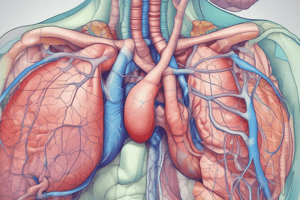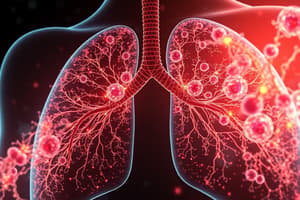Podcast
Questions and Answers
What primarily contributes to the elastic property of the lungs?
What primarily contributes to the elastic property of the lungs?
- Tissue elastic forces from smooth muscle contraction
- Elastic forces generated by the movement of the diaphragm
- Elastic forces from elastin and collagen fibres in lung parenchyma (correct)
- Elastic properties of the pulmonary arteries
In normal adults, what is the total compliance of both lungs together?
In normal adults, what is the total compliance of both lungs together?
- 150 ml of air per cm of water transpulmonary pressure
- 200 ml of air per cm of water transpulmonary pressure (correct)
- 300 ml of air per cm of water transpulmonary pressure
- 250 ml of air per cm of water transpulmonary pressure
How are the tissue elastic forces and fluid air surface tension elastic forces divided in total lung elasticity?
How are the tissue elastic forces and fluid air surface tension elastic forces divided in total lung elasticity?
- 1/4 tissue elastic forces and 3/4 fluid air surface tension forces
- 1/2 tissue elastic forces and 1/2 fluid air surface tension forces
- 1/3 tissue elastic forces and 2/3 fluid air surface tension forces (correct)
- 2/3 tissue elastic forces and 1/3 fluid air surface tension forces
What is the compliance of the lungs and chest wall combined in terms of lung volume change per unit change in airway/alveolar pressure?
What is the compliance of the lungs and chest wall combined in terms of lung volume change per unit change in airway/alveolar pressure?
What represents the compliance of the lungs alone, excluding the thoracic cage?
What represents the compliance of the lungs alone, excluding the thoracic cage?
What represents a condition where lung compliance is increased?
What represents a condition where lung compliance is increased?
Which physiological component directly affects the slope of the pressure-volume curve?
Which physiological component directly affects the slope of the pressure-volume curve?
How does a stiffer lung affect the pressure required for inflation?
How does a stiffer lung affect the pressure required for inflation?
In which condition would the compliance curve be shifted downward and to the right?
In which condition would the compliance curve be shifted downward and to the right?
What is the normal compliance value expressed in liters per cmH2O?
What is the normal compliance value expressed in liters per cmH2O?
Which of the following conditions specifically causes decreased lung compliance?
Which of the following conditions specifically causes decreased lung compliance?
What is the effect of supine position on lung compliance?
What is the effect of supine position on lung compliance?
Which condition is associated with a flatter compliance curve?
Which condition is associated with a flatter compliance curve?
Which part of the pleura is inseparable from the lung tissue itself?
Which part of the pleura is inseparable from the lung tissue itself?
What is the term used to describe the measure of expansibility of the lungs?
What is the term used to describe the measure of expansibility of the lungs?
Which type of pleura covers the thoracic surface of the diaphragm?
Which type of pleura covers the thoracic surface of the diaphragm?
What is the significance of the costo-diaphragmatic recess in the respiratory system?
What is the significance of the costo-diaphragmatic recess in the respiratory system?
Which pleura is subdivided based on the structures it lines?
Which pleura is subdivided based on the structures it lines?
At which rib level does the lower limit of the pleura approximately sit at the mid-axillary line?
At which rib level does the lower limit of the pleura approximately sit at the mid-axillary line?
Which of these statements about lung compliance is false?
Which of these statements about lung compliance is false?
The costo-mediastinal recess is located between which two pleural layers?
The costo-mediastinal recess is located between which two pleural layers?
What is the primary role of surfactant in the alveoli during expiration?
What is the primary role of surfactant in the alveoli during expiration?
How does the concentration of surfactant change when the size of the alveolus decreases?
How does the concentration of surfactant change when the size of the alveolus decreases?
What effect does surfactant have on lung compliance?
What effect does surfactant have on lung compliance?
According to Laplace's Law, what happens to pressure when the radius of an alveolus is halved?
According to Laplace's Law, what happens to pressure when the radius of an alveolus is halved?
What is a consequence of surfactant deficiency in the lungs?
What is a consequence of surfactant deficiency in the lungs?
Which component is NOT typically found in alveolar surfactant?
Which component is NOT typically found in alveolar surfactant?
What important function does surfactant perform related to alveolar stability?
What important function does surfactant perform related to alveolar stability?
What is the role of surfactant in relationship to immune function in the lungs?
What is the role of surfactant in relationship to immune function in the lungs?
What is the role of tubular myelin in the alveoli?
What is the role of tubular myelin in the alveoli?
Which aspect of surfactant metabolism aids in maintaining the surfactant balance in the alveoli?
Which aspect of surfactant metabolism aids in maintaining the surfactant balance in the alveoli?
What is the primary consequence of insufficient surfactant secretion in premature infants?
What is the primary consequence of insufficient surfactant secretion in premature infants?
What physiological condition is primarily affected by the surfactant components in newborns?
What physiological condition is primarily affected by the surfactant components in newborns?
How are surfactant components initially produced within the cells?
How are surfactant components initially produced within the cells?
What is a common treatment for infants with surfactant deficiency?
What is a common treatment for infants with surfactant deficiency?
During exocytosis, where are surfactant components secreted?
During exocytosis, where are surfactant components secreted?
What is a significant factor affecting the lung development of a fetus related to surfactant production?
What is a significant factor affecting the lung development of a fetus related to surfactant production?
Flashcards
Lung Compliance
Lung Compliance
The ability of the lungs to stretch and expand when pressure is applied.
Transpulmonary Pressure
Transpulmonary Pressure
The pressure difference between the inside of the alveoli and the outside of the lungs.
Lung Elasticity
Lung Elasticity
The force that resists the expansion of the lungs, coming from the elastic properties of lung tissue and surface tension.
Surface Tension Elastic Forces
Surface Tension Elastic Forces
Signup and view all the flashcards
Lung Compliance (ΔV/ΔP)
Lung Compliance (ΔV/ΔP)
Signup and view all the flashcards
Pulmonary Compliance
Pulmonary Compliance
Signup and view all the flashcards
Alveolar Pressure
Alveolar Pressure
Signup and view all the flashcards
Pleural Pressure
Pleural Pressure
Signup and view all the flashcards
High Compliance
High Compliance
Signup and view all the flashcards
Decreased Compliance
Decreased Compliance
Signup and view all the flashcards
Increased Compliance
Increased Compliance
Signup and view all the flashcards
Surface tension
Surface tension
Signup and view all the flashcards
Pleura
Pleura
Signup and view all the flashcards
Surface tension in small alveoli
Surface tension in small alveoli
Signup and view all the flashcards
Surface tension in large alveoli
Surface tension in large alveoli
Signup and view all the flashcards
Parietal Pleura
Parietal Pleura
Signup and view all the flashcards
Coexistence of alveoli
Coexistence of alveoli
Signup and view all the flashcards
Visceral Pleura
Visceral Pleura
Signup and view all the flashcards
Pleural Recesses
Pleural Recesses
Signup and view all the flashcards
Surfactant
Surfactant
Signup and view all the flashcards
Type II cells
Type II cells
Signup and view all the flashcards
Costomediastinal Recess
Costomediastinal Recess
Signup and view all the flashcards
Costodiaphragmatic Recess
Costodiaphragmatic Recess
Signup and view all the flashcards
Respiratory distress syndrome (RDS)
Respiratory distress syndrome (RDS)
Signup and view all the flashcards
Surfactant replacement therapy
Surfactant replacement therapy
Signup and view all the flashcards
Elastic Fibers of Lung Parenchyma
Elastic Fibers of Lung Parenchyma
Signup and view all the flashcards
Surface Tension in Alveoli
Surface Tension in Alveoli
Signup and view all the flashcards
Laplace's Law
Laplace's Law
Signup and view all the flashcards
Alveolar Stabilization
Alveolar Stabilization
Signup and view all the flashcards
Prevention of Alveolar Collapse
Prevention of Alveolar Collapse
Signup and view all the flashcards
Pulmonary Edema
Pulmonary Edema
Signup and view all the flashcards
Increased Lung Compliance
Increased Lung Compliance
Signup and view all the flashcards
Surfactant and Immune Function
Surfactant and Immune Function
Signup and view all the flashcards
Study Notes
Respiratory System
- This presentation covers the respiratory system, focusing on the pleura, lung compliance, and pulmonary surfactant.
Learning Outcomes
- To understand the pleura and diaphragmatic recesses
- To define lung (pulmonary) compliance and its determinants
- To describe the role of elastic fibers in lung parenchyma compliance
- To elucidate the role of pulmonary surfactant concerning surface tension and its clinical ramifications
Pleura
- The pleura is a closed serous sac.
- It has two layers: visceral and parietal pleurae.
- These layers are continuous around the lung roots and pulmonary ligaments.
- Visceral pleura closely adheres to the lung, while the parietal pleura lines the thoracic cavity.
Pleura - Layers
- Parietal pleura is subdivided into costal, diaphragmatic, cervical and mediastinal pleurae.
- Costal pleura lines the inner surface of the sternum, ribs, costal cartilages, and intercostal spaces.
- Diaphragmatic pleura covers the thoracic surface of the diaphragm.
- Cervical pleura extends from the first rib to the apex of the lung, connecting with the mediastinal pleura.
- Mediastinal pleura forms the lateral boundary of the mediastinum and covers the mediastinal surface of the lungs.
Recesses of Pleura
- Pleural recesses are widenings in the pleural cavity.
- They act as reserve spaces for lung expansion during deep inspiration.
- Costomediastinal recess: Between costal and mediastinal pleurae.
- Costodiaphragmatic recess: Between costal and diaphragmatic pleurae. These recesses are prominent in reference to the cardiac notch of the lung. At mid-clavicular, mid-axillary, and scapular lines respectively, the lower limit of the pleura is along ribs 8, 10 and 12. The lower border of the lung follows ribs 6, 8 and 10.
- These recesses allow for maximum lung expansion during inspiration. If fluid leaks into the pleural cavity, this fluid first collects in the costodiaphragmatic recess.
Determinants of Lung Compliance
- Lung compliance is the measure of lung expansibility.
- Two factors determine lung compliance
- Elastic Property of the lung.
- Tissue elastic properties due to elastin and collagen fibers in lung parenchyma and elastic forces from the surface tension of lung alveolar fluid.
- Elastic property of the thoracic cage is due to the rib's elastic nature, muscle, and tendon
- Elastic Property of the lung.
Lung Compliance
- The total compliance of both lungs in a normal adult is 200 ml of air per cm of water transpulmonary pressure.
- Tissue elastic forces account for 1/3 of the total lung elasticity, while fluid surface tension elastic forces contribute 2/3.
- The total amount of work done during breathing is the loop area.
Pressure-Volume Curve
- Lung compliance is a static measurement of lung and chest recoil (or ability to return).
- The curve during inflation differs from the curve during deflation, which is termed hysteresis.
- Lung volume at any given pressure during inhalation is less than the lung volume at the same pressure during exhalation.
Compliance Calculations
- Normal Compliance: 0.1 liter/cmH2O
- Low compliance: 0.05 liter/cmH2O
- High compliance: 0.17 liter/cmH2O
Factors Affecting Lung Compliance
- Decreased compliance: pulmonary congestion, interstitial pulmonary fibrosis, supine position, restrictive lung disease, pneumothorax, hydrothorax, asthma.
- Increased compliance: emphysema, old age.
Surface Tension
- Alveoli are lined with a thin layer of fluid with an interface between air and water.
- Water molecules at the surface of the alveolar fluid have inward-pulling forces (surface tension) causing the alveoli to collapse.
- Surfactant is a key factor preventing alveolar collapse.
Action of Surfactant
- The presence of surfactant reduces surface tension.
- Surfactant content in each alveolus is relatively constant. Lowering of surface tension when alveolus size decreases results in a similar pressure increase.
- The action of surfactant is regulated by the law of Laplace (P = 2T/r).
Functions of Alveolar Surfactant
- Stabilizes alveoli of varying radii.
- Prevents collapse of alveoli during expiration.
- Prevents pulmonary edema.
- Increases lung compliance by reducing the centripetal force of surface tension in alveoli and increasing the lungs' stretchability.
- Regulates lung inflammation and facilitates phagocytosis.
Surfactant
- A lipid substance that reduces surface tension.
- Primarily dipamitoylphosphatidylcholine (DPPC)
- Mixture of other lipids and proteins
- Prevents alveoli from collapsing during expiration and prevents pulmonary edema
Formation of Surfactant
- Surfactant components are synthesized from precursors in the endoplasmic reticulum and transported via Golgi apparatus.
- Transported through multi-vesicular bodies and packaged in lamellar bodies.
- Release via secretion (exocytosis).
- Components organize as a lattice (tubular myelin) within the alveoli.
- This is believed to generate phospholipids necessary to create a monolayer at the air-liquid interface, lowering surface tension.
Metabolism of Surfactant
- Phospholipids and proteins are subsequently absorbed by Type II cells, stored in lamellar bodies, then recycled and returned to the alveolar lumen.
- Alveolar macrophages may take up some surfactant in the liquid layer as well.
Respiratory Distress Syndrome (IRDS)
- A syndrome in newborns characterized by poor lung function due to the lack of sufficient surfactant.
- Interventions to minimize risk:
- use of antenatal steroids
- appropriate resuscitation and use of CPAP
- Early administration of surfactant
Studying That Suits You
Use AI to generate personalized quizzes and flashcards to suit your learning preferences.



